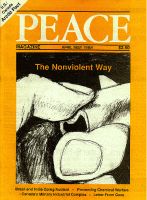
Peace Magazine Apr-May 1988, page 26. Some rights reserved.
Search for other articles by Metta Spencer here
Search for other articles by Kathleen O'Hara here
Search for other articles by Robert Penner here
BY KATHLEEN O'HARA
HONOLULU-- The Canadian government intends to go on using an uninhabited Hawaiian island as a target range for naval bombardment. Mini-ster of Defence Perrin Beatty has indicated that Canada will use Kaho'olawe for target practice in May of 1988 during RIMPAC military exercises.
Kaho'olawe, with 544 known archaeological sites, is a link to 1,000 years of Hawaiian culture. In recognition of its historic importance, the entire island is on the U.S. Registry of Historic Sites.
Requests that our government stop using the island have come from the Hawaiian State Senate and Congress, from a Hawaiian federal Senator, from the Mayor and Council of Maui..
In 1986, 38 major Canadian peace organizations and 24 prominent Canadians asked the government to stop bombing the site. The Prime Minister did not even even acknowledge the letter. Urgent action is needed. For more information: South Pacific Peoples Foundation of Canada. 409-620 View St., Victoria, B.C. V8W 1J6. (604) 381-4131.
BY METTA SPENCER
UNITED NATIONS -- Beginning June 12, the United Nations will hold its third Special Session on Disarmament (UNSSOD III). The Preparatory Committee met at the U.N. from January 25 to February 5 to plan the agenda.
Most observers do not believe that 1988 is a good year for such a meeting, since the U.S. election campaign will be in full swing. Ambassador Douglas Roche has expressed dissatisfaction with the results of the Preparatory Committee's meeting, chiefly because it was impossible to agree upon a document to be presented to the Session. If the members are presented with no initial document, the prospects seem dim for the entire Session to arrive at a strong final document.
The United States, which boycotted last year's session that met to explore the connections between disarmament and development, will again not allow for any connection to be made between these two issues. However, the Disarmament and Development Conference had instructed that the topic must be included on the agenda of UNSSOD III, and some discussion will certainly take place, at least during the plenary sessions. However, since UNSSOD III will operate on the basis of consensus, the Americans will be able to block any inclusion of these topics on the agenda.
Canadian observers noted a mixture of hope and resignation in the mood at the Preparatory Committee. The hope reflects the recent progress that the U.S. and USSR have made in such areas as the INF Treaty. The resignation reflects the sense that any additional progress may have to be bilateral, not multilateral. Previously, U.N. delegates have forcibly claimed that nuclear arms negotiations should involve all nations, but this insistence seems diminished these days.
The first objective of the Special Session in June will be to assess the current state of international affairs and the existing U.N. machinery for addressing disarmament concerns: The Conference on Disarmament, the Disarmament Commission, the World Disarmament Campaign, the U.N. Disarmament Research Institute, and the Disarmament Fellowship program will probably be scrutinized. The point is to question whether these are still functioning and appropriate for the tasks that seem to lie ahead. Some of these existing agencies will be strengthened and other new ones may be created. Since the World Disarmament Campaign works closely with non-governmental organizations (NGOs), its review will be partly done by NGOs. Moreover, some NGOs will have an opportunity to speak to the Session.
The six leaders of the Five Continent Peace Initiative will attend UNSSOD III. They met in Stockholm in January and drafted a new document, the Stockholm Declaration, which calls for an International Verification Network to be established under U.N. auspices. At UNSSOD III they will spell out the details of this proposal.
Mobilization for Survival, a U.S. peace organization, is coordinating plans for appropriate public support for UNSSOD III. Unlike the dramatic mass march in 1982, when nearly one million people converged on Central Park, plans this time call for separate manifestations in the capital cities of the world. The Canadian Peace Alliance, which will be meeting in Ottawa on June 12, will recess its conference to participate in the larger public event.
Schlaining, Austria: In the fall of 1989, a three-month pilot semester will begin here for a post-graduate European Peace University under UNESCO auspices. Students and faculty will come from all countries belonging to CSCE -- Europe and North America. The feasibility of current plans is being evalutated by delegates from Marhc 23 to 25. Canada is represented here by Professors Jean-Guy Vaillancourt (Université de Montréal) and Metta Spencer (University of Toronto).
By Robert Penner
Ottawa: The 1988 Canadian Peace Alliance Convention will meet at Carleton University, June 10-13. The keynote speaker, James Anderton, is the New Zealand M.P. who spearheaded that country's Nuclear Weapons Free Zone campaign. On Satuirday there will be an event in support of the third United Nations Special Session on Disarmament. On Monday, mass lobbying will take place on Parliament Hill. There will be discussion of the strategies and direction of the peace movement in Canada.

Peace Magazine Apr-May 1988, page 26. Some rights reserved.
Search for other articles by Metta Spencer here
Search for other articles by Kathleen O'Hara here
Search for other articles by Robert Penner here